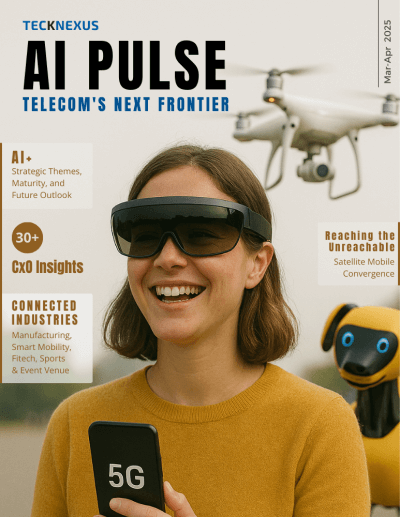Introduction: A Focus on Innovation with Rupesh Choksi
Rupesh Choksi, stationed in Dallas, Texas, serves as the Vice President for Product Strategy and Innovation at AT&T. Alongside his team, he wakes up each day with a singular focus on innovation and the development of the next generation of products and services. They are channeling considerable investments into expanding their fiber footprints and 5G, aiming to deliver automated, self-service, and software-centric products that leverage these core assets. Choksi and his team zero in on 5G, edge technology, and cybersecurity, diving deeper into specific verticals such as healthcare, manufacturing, public sector, retail, and financial services to deliver unique solutions to the marketplace.
AT&T’s Impressive Reach of 5G
5G technology, with its nationwide availability, reaches 255 million people across more than 16,000 cities and towns. This technology, bolstered by millimeter wave rollouts and C-band rollouts, offers impressive high-speed, geographic coverage, and availability. New use cases are emerging, especially for enterprise and mid-market customers across manufacturing, healthcare, industrials, retail, and financial services sectors. The capabilities of lower latency and massive connectivity, crucial for IoT and network requirements, are enabling these customers to reimagine business processes, smart factories, and smart cities, taking full advantage of the network capabilities.
Deploying Private 5G Edge Technology
AT&T launched its Private 5G Edge earlier in the year in collaboration with Microsoft, diving deeper into the customer edge by utilizing both licensed and unlicensed spectrum capabilities. This technology, aimed at smaller footprint locations such as manufacturing plants, healthcare facilities, car dealerships, and other storefronts, employs computer vision. A substantial amount of video cameras, AI software, and machine learning is leveraged to automate daily tasks and operations through video and computer vision, enabled significantly by the 5G network’s low latency and high-speed processing at the network edge.
Transforming Industries with Sensor and Endpoint Connectivity
The number of sensors and endpoints connecting to the network is growing, particularly in the healthcare industry, where technology is being employed to enhance patient experiences and address challenges such as aging in place and workforce shortages. Customers are persistently focusing on utilizing cellular technology, and with the advent of 5G, this utilization is being supercharged. Its adoption is being witnessed across all the different verticals mentioned, with numerous additional use cases being explored and developed.
The Amplified Potential with 5G Technology
The 5G technology, with its amplified capabilities, is being adopted across various verticals, opening new doors for innovative use cases and enhanced operational efficiencies. From smart healthcare solutions to automating manufacturing processes and enhancing customer experiences in retail, the low latency and high-speed connectivity provided by 5G are enabling businesses to reimagine and transform their operations, paving the way for a future where connectivity and smart solutions are at the forefront of business strategy and customer experiences.
Utilizing 5G for Autonomous Everything
The vision of autonomous everything is significantly empowered by 5G and its associated edge capabilities. Choksi observes applications across a continuum, from Fortune 10 companies to small-scale customers, utilizing these technologies to enhance business outcomes such as improving end-user experiences, boosting resource productivity, and innovating new customer experiences.
Security in the 5G Era
Security, particularly in the age of 5G, is a top priority, resonating in boardroom conversations and being crucial to various C-level executives due to its potential brand impact. While 5G standards continue to evolve, learnings from 4G have been integrated into 5G networks to enhance inherent security, such as data encryption. However, security is not a one-and-done task; it’s a multifaceted challenge that requires ongoing attention and investment, especially considering the expansion of IoT endpoints and thus, a different and expanded attack surface.
Focusing on Customer and Network Edge
Choksi identifies that deploying capabilities within customer boundaries is vital, whether in branches, retail offices, hospitals, manufacturing locations, storefronts, or banks. The network edge, especially within metros, serves multiple customers while maintaining a keen focus on security and ensuring appropriate deployment of apparatus for multi-tenancy networks, safeguarding customers utilizing this infrastructure.
Implementing Zero Trust Models and SASE
In an era where data is diffused across multiple locations and diverse types of endpoints and devices are emerging, traditional security thinking is becoming less effective. The Zero Trust model comes into play here, providing a framework that helps navigate the edge computing landscape. AT&T has worked extensively on Secure Access Service Edge (SASE), which takes on the Zero Trust model, contemplating a very different perimeter from an enterprise perspective. SASE is crucial for customers, focusing on securely accessing various resources, enforcing access controls and policies, and continuously inspecting, monitoring, and managing threats both proactively and reactively.
Navigating Through Private 5G Environments
Choksi observes momentum in the adaptation and adoption of private 5G environments, with many customers contemplating how they will navigate this space. AT&T has been active in this space, working with 5G managed advanced security solutions, where certain next-gen firewall functionality can be combined with multi-access edge compute (MEC) capabilities. Looking at various protocols and data flows, behavioral analytics are applied to assess whether devices are performing as they should.
IoT Growth and Security Challenges
The rapid expansion of IoT connections, from connected vehicles to healthcare devices, indicates a reality where every new entity, be it a car or a health monitor, is connected. However, this interconnectivity brings to light significant concerns regarding securing these connections, given the nature of the information being transferred and the necessity to comply with regulatory standards like HIPAA, PCI, and GDPR. Furthermore, Choksi expresses a concern regarding the pace at which new endpoints are being introduced to networks, which is notably faster than the rate at which security software and apparatus are being developed and implemented.
The Role of 5G in Securing Connections
5G technology offers enhanced privacy and encrypted information flow, safeguarding identities and data transmission. Yet, security goes beyond ensuring encrypted connections; it also involves utilising behavioural analytics and other methodologies to monitor device behaviour, particularly in IoT endpoints. This involves conducting discovery processes, performing vulnerability scans, and ensuring patch management, while also maximising the encryption and network slicing capabilities offered by cellular technology to enhance the end-to-end secure flow of information.
Striking a Balance: IoT and OT Security
Choksi identifies operational technology (OT) and IoT security as both a challenge and an opportunity. The challenge lies in securing the rapidly increasing number of endpoints, while the opportunity is found in collectively focusing on locking down IoT and OT environments. Threats have evolved, moving from traditional IT to targeting operational, manufacturing, and infrastructure environments, which underscores the necessity to secure IoT and OT in these domains significantly.
Embedding Security into Design and Innovation
Security should not be an afterthought, but rather, it should be embedded into the design processes from the outset. Choksi believes that innovations in 5G will primarily be driven within the enterprise space, linking to the mobile, customer, and network edge. The goal is to grow the capabilities in the network, delivering on low latency, high-speed application experiences while ensuring thorough threat detection and inspection of sources for all devices. With a Zero Trust framework and continuous focus on network security, the strategy is to uphold innovation while keeping cybersecurity at its core, allowing for focus on outcomes without worrying about potential exposure.
Conclusion: Innovating with Security at the Forefront
With over 400+ petabytes of data traversing global networks daily, the innovation of AI and ML and the scale at which it is being implemented is crucial. 5G brings forth numerous features and functionalities, from network slicing to private routing, all promising exciting innovations. However, as networks become more programmable, it’s imperative to keep security at its core, ensuring that vulnerabilities and attack surfaces are minimized, thus permitting a focus on outcomes without the looming threat of exposure.
Related Content:























